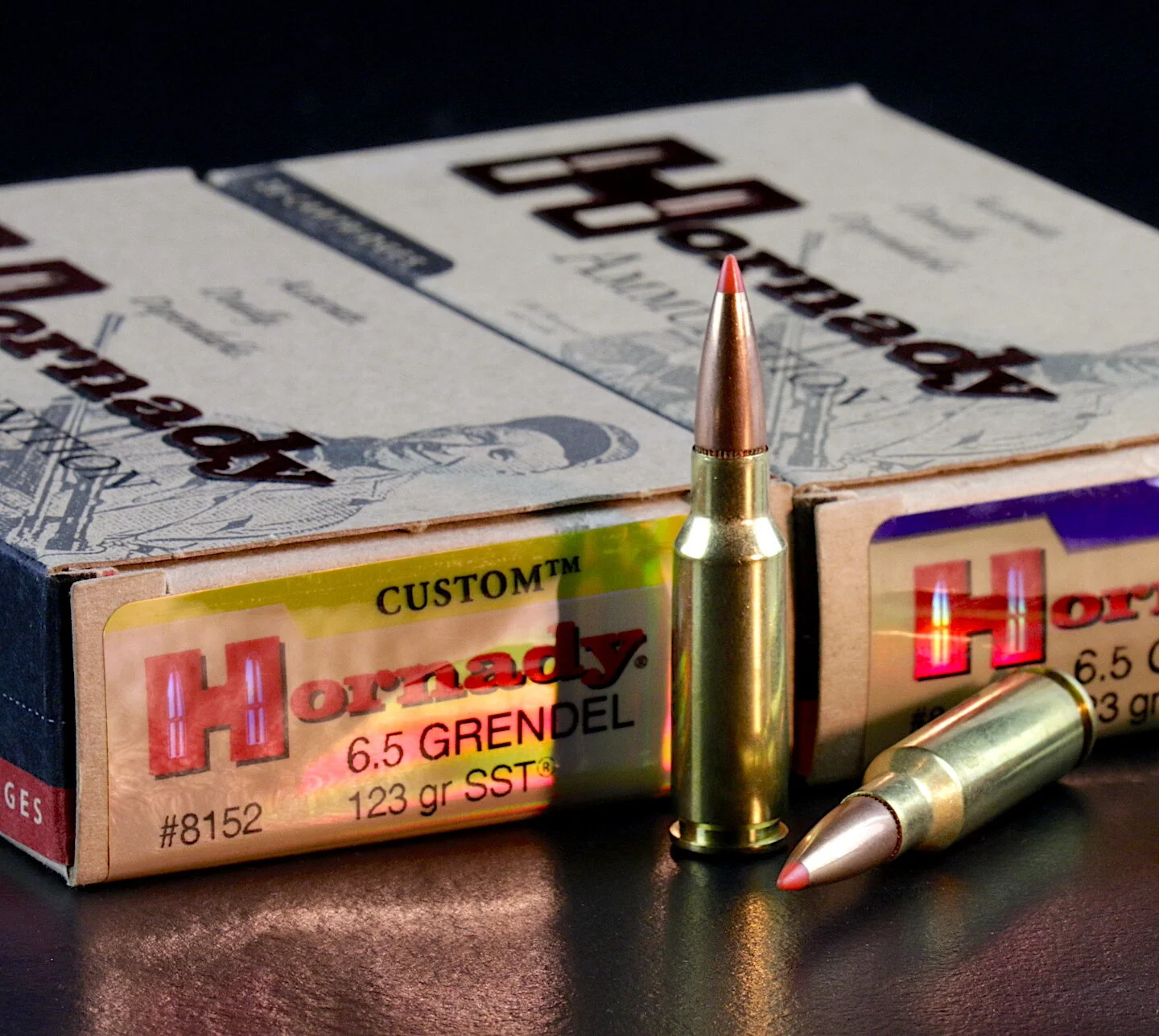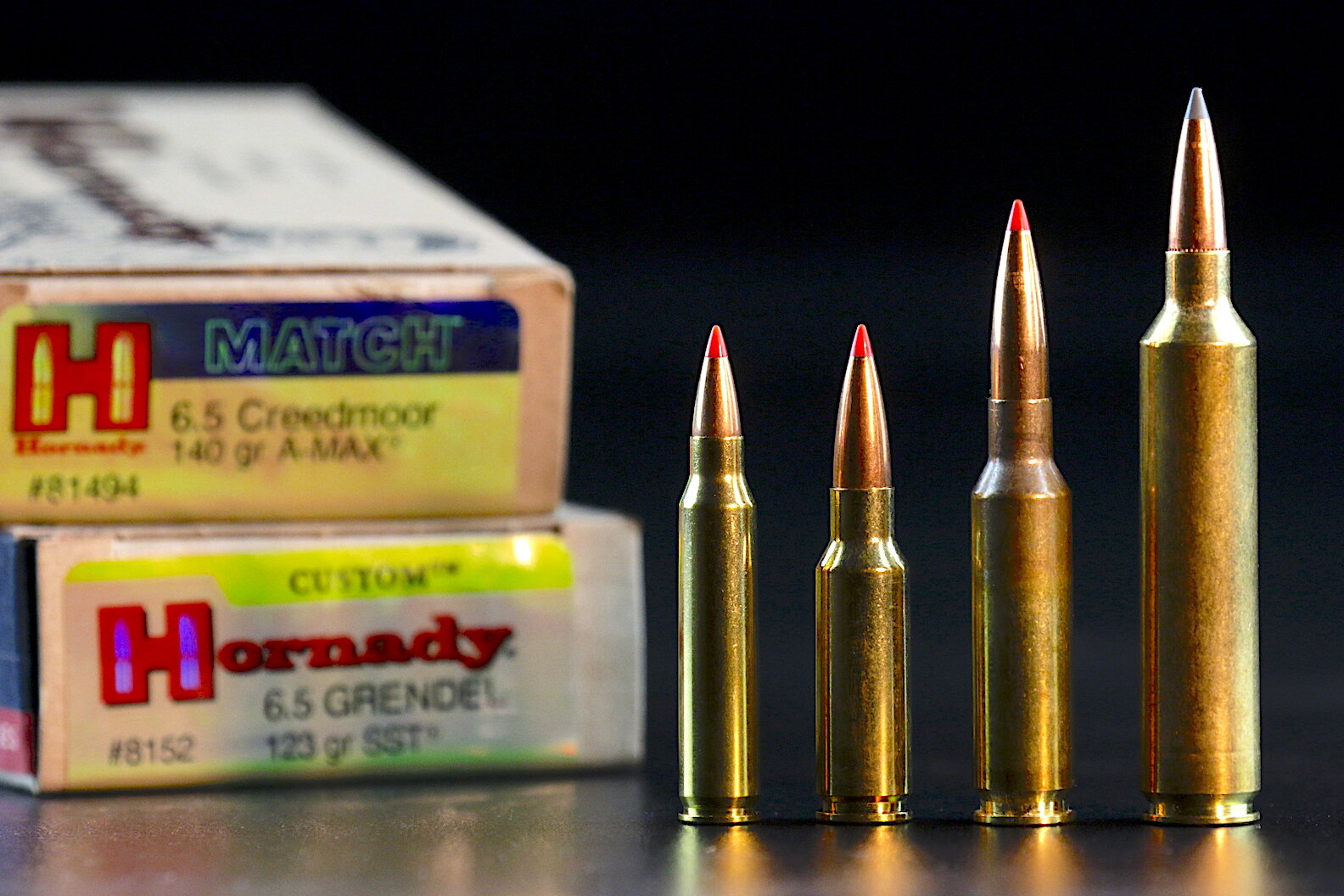6.5 Grendel: The Little Cartridge that Could
by Ron Spomer
It thinks it can it thinks it can it thinks it can…
If you were writing a childrens’ book about deer hunting cartridges, the little 6.5 Grendel would play the roll of the Little Engine That Could. This is our smallest 6.5 centerfire. It’s case measures just 1.516 inches base to mouth. Even with a long, high B.C. bullet seated, overall length is just 2.26 inches. With a 123-grain bullet seated, the Grendel’s water capacity is 30-grains, about 7 grains less than the 30-30 Winchester, some 17 grains less water capacity than the 6.5 Creedmoor, 20 grains less than the 243 Winchester.
Despite all these short comings, the 6.5 Grendel has been proven again and again to topple large deer in a single bound.
Say hello to super Grendel, the little .264 that can. And does. Without slapping you or anyone else upside the head.
Don’t Kick the 6.5 Grendel (cause it won’t kick you)
Reduced recoil is a major selling point of the 6.5 Grendel. Ballistic performance — not so much. But more than good enough. In an 8-pound rifle a full-house 123-grain load will churn up 8.8 f-p of recoil energy moving 8 fps back into your shoulder. That’s about a pound less kick than a 243 Winchester driving a 95-grain bullet. Zero that 123-gr. .264 bullet 3 inches high at 125 yards and it won’t drop more than 3 inches until about 265 yards. At that distance it’ll still be carrying 1,250 f-p of energy. It remains super sonic to about 1,200 yards, faster than the excellent, 155-grain Hornady ELD-Match in a 308 Winchester.
Runt of the 6.5mm Litter
Compared to some of its bigger 6.5mm cousins, the Grendel is the runt of the litter. Even the old military 6.5 Jap, 6.5 Carcano, and 6.5x54 Mannlicher-Schoenauer hold more powder. But like many runts, the 6.5 Grendel punches above its weight class.
Many use the benchmark of 1,000 foot-pounds kinetic energy in a bullet as the minimum for really good terminal performance on deer-sized game with proper placement of an expanding hunting bullet. The Grendel delivers this at 400 yards with a little 123-grain bullet launched at 2,580 fps from the muzzle. That’s the top speed Hornady claims for one of its factory loads. Handloaders may or may not be able to match it, but should be capable of hitting 2,500 fps from a 20-inch, certainly a 22-inch barrel.
6.5 Grendel, 123-grain Hornady SST Ballistics. The 123-grain is the sweet spot for the 6.5 Grendel, maximizing retained energy with a nice balance of drop and drift.
Short Barrels for Short 6.5 Grendel
Short barrels are kind of a standard for the Grendel because in 2002 Bill Alexander of Alexander Arms designed it as a military battle cartridge specifically for short barreled AR-15 style rifles, some as short as 14.5 inches. He modified a PPC cartridge or the 7.62x39 Russian to make the Grendel. Like so many military cartridges, the Grendel has been tested by sport hunters and declared acceptable, even outstanding. But how, in a world that has been pushing 6.5mm cartridge velocities ever since the 6.5x55 Swede of 1892, how did we slide back to 2,500 fps? The 6.5-300 Weatherby Magnum hits 3,500 fps with a 129-grain bullet. The 26 Nosler claims 3,600. How did a pipsqueak round like the Grendel ever find itself in the deer woods?
The extra-short 6.5 Grendel was designed to shoot “harder” than the 223 Remington in AR-15 platforms, so it’s not as fast or powerful as the 6.5 Creedmoor to its right — and certainly not the towering 26 Nosler.
Efficiency would be my guess. Once SAAMI officially sanctioned the Grendel in 2010, AR shooters discovered its performance advantages over the 223 Remington — the higher energies downrange, the wider and heavier bullets for deeper penetration, the light recoil — and the bandwagon began rolling. When manufacturers like Howa started chambering it in extra-short action bolt rifles, the hunting world truly started to notice.
Howa You Would Like This Little Rifle
Howa’s Mini Action, dual-lug bolt was one of the first, if not the first, bolt actions chambered as a sporting rifle in 6.5 Grendel. Light, quick, handy and deadly on varmints, coyotes, and deer-sized game at all sensible ranges.
Howa’s Mini Action is about 12 percent shorter — almost an inch — than typical 308-length short-actions. Mated to a 20-inch barrel and secured to a pillar-bedded, synthetic stock, the dual-locking-lug Mini Action shoots sub-MOA (guaranteed) and weighs right around 5 1/2 pounds. Scoped and field ready it should weight about 6 1/2 pounds, meaning recoil would be about 10.4 f-p at 10.2 fps. You see where this is going? Light, handy, quick, soft recoiling, sufficiently flat-shooting for a 260-yard MPBR on a 6-inch target… We’ve got a superb deer rifle for young, small-framed, and recoil sensitive shooters, especially in hunting habitat where shots rarely exceed 250 yards. Given how many whitetail hunters stand-hunt in places where shots rarely exceed 100 yards, the 6.5 Grendel isn’t just adequate; it’s almost overkill. Yet it has less recoil and muzzle blast than the 30-30. What’s not to like?
Study the ballistics charts in this post and you’ll begin to appreciate the 6.5 Grendel. It’s not the long range performer of its Creedmoor cousin, but it give the venerable 243 Winchester a run for its money. The 243 with a 95-grain Sierra Tipped Game King drops considerably less and deflects a bit less in crosswinds, but retained energy levels are about the same with both.
6.5 Grendel, 129-grain Nosler AccuBond Long Range
6.5 Creedmoor, 143-grain Hornady ELD-X
The 6.5 Grendel will spit bullets as light as 95-grains about 2,700 fps, suggesting a good predator calling rifle. You can go as heavy as you’d like with handloading, but most handloading manuals stop at 130-grains. So do most factory loads. Performance is maximized with the 123-grain bullets. That’s the sweet spot. Any heavier and downrange energies as well as trajectory suffer.
I’ll admit that when I first saw the 6.5 Grendel I thought it was a useless little round. With soft-shooting Creedmoors already crowding the 6.5mm field, why bother with something weaker? But then I started shooting it and the light went on. It’s like shooting a lighter kicking 243 Winchester in a lighter, shorter, handier rifle that puts slightly heavier, longer bullets with higher Sectional Densities on target. I doubt any deer or hogs will detect a difference, but you might.
Anyone who already has and loves a 243 Winchester won’t gain any ballistic advantage with a 6.5 Grendel, but anyone enamored of truly short, quick actions will likely love one.
243 Winchester, 95-grain Sierra Tipped Game King
Hornady’s 123-grain SST factory load shot this fast across my chronograph set up 10 feet from the muzzle, suggesting Hornady’s claim of 2580 fps is quite accurate.
Recoil Comparisons in 8-pound rifles
6.5 Grendel, 123-gr., 8.8 f-p recoil at 8.4 fps
6.5 Creedmoor, 143-gr.: 15.3 f-p at 11 fps
243 Winchester, 95-gr. : 10.3 f-p at 9.1 fps
270 Winchester, 130-gr.: 19.3 f-p at 12.5 fps









